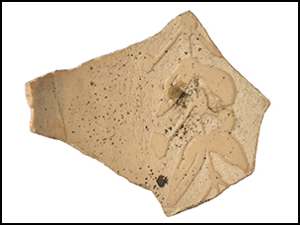Crossref Citations
This article has been cited by the following publications. This list is generated based on data provided by
Crossref.
Stoddart, Simon
2020.
Power and Place in Etruria.
Hodos, Tamar
2020.
Eggstraordinary artefacts: decorated ostrich eggs in the ancient Mediterranean world.
Humanities and Social Sciences Communications,
Vol. 7,
Issue. 1,
Mikhailov, Konstantin E.
and
Zelenkov, Nikita
2020.
The late Cenozoic history of the ostriches (Aves: Struthionidae), as revealed by fossil eggshell and bone remains.
Earth-Science Reviews,
Vol. 208,
Issue. ,
p.
103270.
Binnberg, Julia
Urbani, Bernardo
and
Youlatos, Dionisios
2021.
Langurs in the Aegean Bronze Age? A Review of a Recent Debate on Archaeoprimatology and Animal Identification in Ancient Iconography.
Journal of Greek Archaeology,
Vol. 6,
Issue. ,
p.
100.
Buffetaut, Eric
2022.
The Enigmatic Avian Oogenus Psammornis: A Review of Stratigraphic Evidence.
Diversity,
Vol. 14,
Issue. 2,
p.
123.
Gorzalczany, Amir
and
Rosen, Baruch
2022.
Ostriches and people in archaeological contexts in the southern Levant and beyond.
Levant,
Vol. 54,
Issue. 1,
p.
29.
Knapp, A. Bernard
2022.
Bronze Age Cyprus and the Aegean: ‘exotic currency’ and objects of connectivity.
Journal of Greek Archaeology,
Vol. 7,
Issue. ,
p.
67.
Koch, Ido
2022.
Human–Animal Encounters on Early Iron Age Stamp Seals.
Near Eastern Archaeology,
Vol. 85,
Issue. 4,
p.
296.
Maeir, Aren M.
2023.
“And in Length of Days Understanding” (Job 12:12).
p.
573.
Lü, Qin-Qin
Chen, Yi-Xiang
Henderson, Julian
and
Bayon, Germain
2023.
A large-scale Sr and Nd isotope baseline for archaeological provenance in Silk Road regions and its application to plant-ash glass.
Journal of Archaeological Science,
Vol. 149,
Issue. ,
p.
105695.
Murray, Sarah C.
2023.
Eastern Mediterranean Bronze Age Trade in Archaeological Perspective: A Review of Interpretative and Empirical Developments.
Journal of Archaeological Research,
Vol. 31,
Issue. 3,
p.
395.
Foster, Karen Polinger
2023.
Opium Art and Truffle Texts in the Aegean and Ancient Near East.
Studies in Ancient Art and Civilisation,
Vol. 27,
Issue. ,
p.
77.
Schwimer, Lior
Malkinson, Dan
and
Kolska Horwitz, Liora
2024.
Petroglyphs as a paleobiogeographic guide for Arabian ostrich ecology and reintroduction.
Journal of Arid Environments,
Vol. 224,
Issue. ,
p.
105222.
Schlegel, Valery J.
2024.
Human and Aquatic Beings: Interactions in and beyond the Eastern Mediterranean (3rd—1st Millennia BCE).
p.
103.
Schreiber, Arnd
2024.
Historical ostriches in the Libyan Desert, with ecological and taxonomic considerations.
Natural History Sciences,
Vol. 11,
Issue. 2,
Avisar, Reli
2025.
CONSUMPTION PATTERNS OF A VASSAL: THE CASE OF LACHISH AND JERUSALEM.
Oxford Journal of Archaeology,
Vol. 44,
Issue. 2,
p.
139.
